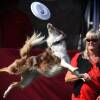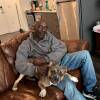Inside an exam room at a veterinary hospital in Walpole, Dr. April Paul crouched down to greet a black and tan German Shepherd named Odin. Not wasting any time, the pup gave her a big kiss. Only one and a half years old, he has a lot of love to give.
Odin was at the hospital to donate blood to other pets in need, alleviating a burdensome wait time for donated animal blood that no owner can afford.
“If we had to buy blood from the national blood bank, I think it takes several months to get here,” Paul said.
While it's not unusual to hear about blood shortages for humans, dogs and cats are as much in need as people.
Most veterinary hospitals in Massachusetts get blood from an out-of-state bank, but Tufts Veterinary Emergency Treatment and Specialties is one of only a few in the state that has its own in-house blood donation program. Its emergency room does one or two emergency blood transfusions a week.
Paul said the situation wasn’t always this dire. But pet owners have become increasingly devoted. According to the American Pet Products Association, Americans spent $29.8 billion in 2018 on their furry companions. More than half of that amount was on medical costs, including emergency blood transfusions.
"We try to keep a good stock on hand, so we have about six canine units in the fridge and one cat unit at all times," Paul said. "If we go through that, we’re calling donors in. Sometimes they can come in right away."
Andrea Hourihan, Odin’s owner and a Walpole resident, has brought her previous dogs in to make emergency donations in the past.
"It doesn't hurt him. They know they can call, and I can be here in 15 minutes," Hourihan said.
The blood collection process usually requires two to three people — not surprising, since donor dogs must weigh at least 50 pounds. At a recent donation session, Hourihan hugged Odin, who was lying on an exam table. She caressed his head as a veterinary technician, Emily Parker, cleaned and shaved the injection site on his neck. The mild sedative Parker gave Odin earlier was starting to take effect, but he was still fidgety, so she called in another tech to hold down his hind legs.
“Not all the donors are sedated. So usually for their first donation, I'll give them sedation just so it's a pretty relaxed situation for them,” Parker said.
She put the blood bag — the same kind used for human donations — on a scale so she could track how much blood she was drawing, the same process used for humans. Afterwards, the blood would be placed in a centrifuge and split into platelets and plasma. The plasma can be used for things like septic abdomens, clotting disorders or rat bait ingestion.
When Parker inserted the needle into Odin, he remained unfazed.
“We just kind of tell them what a good dog they are the whole time,” she said.
Hourihan did just that, never loosening her embrace as Odin’s blood was drawn. “You’re my good boy,” she told Odin.
It was all over in 10 minutes. Afterwards, Odin was back to himself, albeit a little groggy.
This was Odin's second time donating blood, and won’t be the last. He's on a roster of 35 dogs and 15 cats who make regular donations. There are perks, too. In return, donors get a free exam and free blood-work. At the end of the donation, they can wear a plaque around their neck boasting of their altruism — creating the ultimate photo op.
The Tufts vet emergency hospital is always looking for more donors, all of whom need to be healthy and up on their vaccinations. Cats need to be over 10 pounds, live indoors, and spayed or neutered. Dog blood, by the way, is either positive or negative. Cats are either type A or B.
Hourihan's pets have never been on the receiving end of a blood donation, but said she hopes if Odin were ever in need, another dog would do the same for him.
“I want my babies home. And if they're sick and in the hospital, it's just not the same. You want them home. And if that's what it takes to get them home, then I'll do what I can,” she said.
Odin, who handled it all like a champ, headed home to sleep it off — but not without receiving plenty of treats first.




